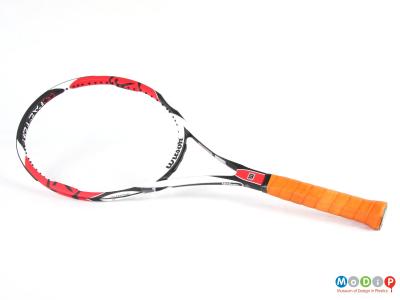Whatever the sport, rackets use technology similar to that of the tennis racket. Key to a racket's performance is its head size, and its stiffness to weight ratio. Carbon composite rackets can have heads 40% larger, be 3 times stiffer and 30% lighter than wooden examples; they also dramatically outperform metal rackets.
The first mass-produced carbon composite racket was the Dunlop Max 200g (1) introduced in 1980 and much used by John McEnroe and Steffi Graf. This racket was injection moulded but most modern rackets including the others displayed are made from grades of carbon fibre woven in different patterns, particular patterns being selected to impart the desired characteristics to particular parts of the racket. The material, impregnated with resin, is rolled around a hollow flexible tube and consolidated within a racket-shaped mould.
Carbon fibre rackets can last for years without noticeable fatigue. The industry depends, therefore, on a stream of innovations often involving proprietary ingredients, with the aim of increasing the energy given to the ball and decreasing the vibration to the player's arm.
The up-to-date version of the Dunlop Max 200g is the Aerogel 200 (2). Aerogel, a plastic foam, is the world's lightest solid and is capable of holding up to 4000 times its own weight. It is placed strategically around the racket to make it stiffer without significantly adding weight.
The Head MicroGel Radical MP (3), currently used by Andy Murray, uses MicroGel, a silicone-based material exclusive to Head, to create a honeycomb structure around the stiff carbon fibres. The MicroGel deforms and compresses upon ball impact, uniformly absorbing and distributing the impact load around the frame.
The Wilson [K] Six, One Tour (4), currently used by Roger Federer, is made of 20% Kevlar®, a Dupont aramid fibre, and 80% Karophite Black, a material exclusive to Wilson that works with nanotechnology to fuse the molecules of high modulus carbon. Also exclusive to Wilson are the Iso-Zorb grommets made from plastic similar to that used in skyscraper foundations to absorb earthquake-generated shock. The Karakal CTi-205 (5) is an example of a composite including a metal. 90% of the racket's composition is a super light high modulus carbon with improved strength and power derived from nano-technology. The other 10% is titanium, some in the frame and some visible at the power flex points. The CTi 205 frame weighs only 205 grams whereas the other rackets weigh between 300-355 grams. The choice of a racket's weight and other characteristics are personal but what the great players share is a preference for carbon composite rackets. This material has changed the way the game is played.





